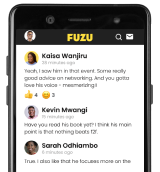Employers should also change processes that create unconscious bias to have a more inclusive and diverse workforce.
Photo credit: Cottonbro
Remember the last time you were in a room- let’s say at home, and lights just went off at night and there was pitch black darkness all over the place, how many things did you knock over despite knowing your around? Did you pause for a minute and thought that’s what blind people experience; trying to find their way in darkness?
A Few years back while in primary school, Henry Wanyoike visited our school to give us a talk. I Wish he could see how amazed and inspired his audience was at his achievements despite him being blind. Seated there in my khaki shorts, I felt challenged. How could this blind guy be so talented at running while I am not (at anything at least)? Running towards a finish line, a goal that he can’t see. All this with the help of a guide only, but still, how? Bagging several gold medals and setting new world records at international track events proved he is just as good as any physically fit person or even better and so is any disabled person. But how many companies out there can employ them?
According to the 2003 Persons with Disability act, both public and private companies are required to reserve 5% of their jobs for the disabled persons. However, with no reliable mechanisms in place, this is far from being implemented to ensure the differently abled persons get job opportunities. A report by Development Initiatives, indicates that according to the 2019 census, 2.2% (0.9 million people) of Kenyans live with some form of disability. Quite a substantial amount to even imagine the untapped talent - people with disabilities represent a significant talent pool.
Most employers are likely to think about the effectiveness and performance of persons with disability to be of low standards, which is not the case. Being differently abled, they can exceed one’s expectations if provided with reasonable accommodation.
The following can be done to provide reasonable accommodation depending on the specific needs of the individuals: -
Mobility impairments
Individuals with lower or upper body impairments require wheelchairs, crutches or canes to support their movements. Just like other employees, these people also need to move from one point to another and therefore need accessible ramps and grab bars. Their workstations too need to be friendly e.g. have tables with adjustable heights.
Visual impairments
Technology advancements have made it possible for the visually impaired to have a more equal playing field with the rest of the workforce with researchers coming up with workplace technology advancements to accommodate them. These include: - braille note takers, text-to-speech screen readers, voice recognition program etc.
Hearing impairments
Hearing impairment may be at different functional levels. As such, an individual may either need amplification devices (hearing aids) or use sign language.
In conclusion,
Differently abled persons already face enough challenges by the time they get to work - being turned down by matatus because it takes them longer to board or have no space for their wheelchairs. It will only be fair for employers to go an extra mile in investing in facilities to ensure that people with disabilities are well accommodated and work with ease. Employers should also change processes that support unconscious bias to have a more inclusive and diverse workforce.

